Is Xiaomi creating a “feast” of cars? Since 2021, Xiaomi has been making a big splash with its announcement of a 10-year, $10 billion investment in car manufacturing. In the past three years, Xiaomi has captured the audience’s attention. At the Xiaomi car technology release event, Xiaomi unveiled many “big moves,” including the appearance of the Xiaomi SU7, addressing some market concerns. However, the price, which is the most important concern for users, is still being kept under wraps.
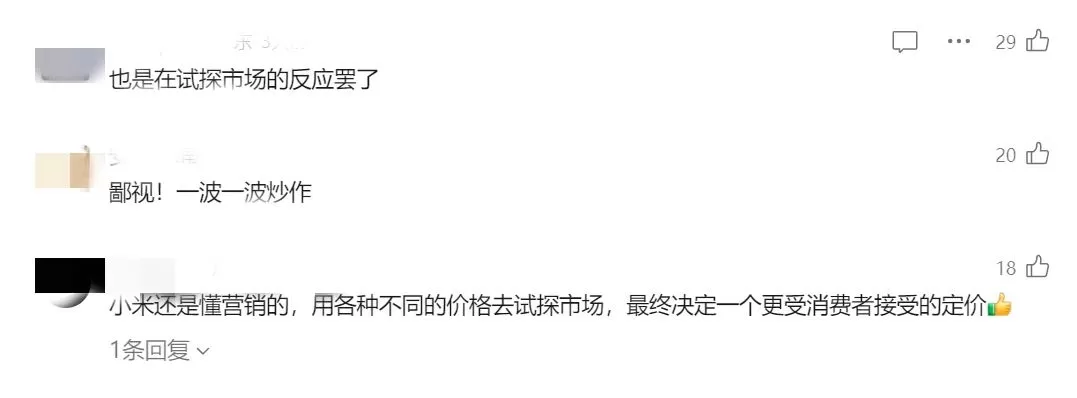
Partial netizen comments But Xiaomi’s purpose has been achieved, all kinds of unverified “rumors” are testing the bottom line of consumers’ acceptance of Xiaomi cars, adding fuel to the fire for the upcoming Xiaomi SU7, and also attracting high attention to Xiaomi’s car suppliers, causing many listed companies in the automotive supply chain to face numerous inquiries from investors about cooperation with Xiaomi cars on interactive platforms. A table of “good dishes” On January 2, a spokesperson for Xiaomi company stated, “We have recently noticed a picture related to the Xiaomi car industry chain, and after verification, at least 50% of the content is completely incorrect. We are deeply puzzled by the misleading information and its impact on the public and investors. We hereby clarify.”

Image source: Xiaomi company spokesperson official Weibo The market’s “excessive attention” to Xiaomi suppliers may be related to the long-standing rumors of Xiaomi’s “supply chain car-making.” After all, Xiaomi is not only a master of hunger marketing, but also an expert in playing with the supply chain.
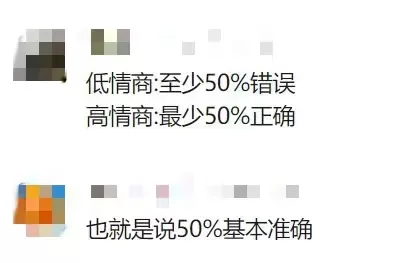
Some netizens’ comments By summarizing and sorting out the official announcements and financial reports of relevant supply chain companies, as well as the comments on the interactive platform, combined with some officially confirmed suppliers, the automotive industry chain companies related to Xiaomi’s car can be roughly divided into the following categories. One category is companies that have cooperated or had cooperation with Xiaomi’s car. Among them, companies like Bosch, Qualcomm, Top Group, and Hesai Technology have been officially confirmed to supply parts for Xiaomi’s SU7. It is reported that Bosch supplies the ESP stability system and DPB brake controller for Xiaomi’s SU7, the acceleration sensor is provided by Continental Teves, the four-piston fixed caliper and perforated ventilated brake disc are supplied by Brembo, the steering gear supplier is NSK, the wheel hub bearing supplier is Schaeffler, the CDC shock absorber supplier is ZF, and the suspension structure component supplier is Benteler.

More than 40 domestic industrial chain companies have become partners of Xiaomi’s car, in addition to overseas suppliers, according to incomplete statistics. It is worth noting that the companies involved in the figure may not necessarily supply mass-produced models to Xiaomi, but are explicitly cooperating with Xiaomi’s car-related business or entering Xiaomi’s supplier system. For example, Sanlian Forging developed wheel bearing OTS samples for Xiaomi’s new energy vehicles in 2022, Yangjie Technology stated that the company has entered the list of qualified suppliers for Xiaomi’s car, and most other companies such as Xiangxin Technology and Guangting Information only revealed cooperation with Xiaomi’s car, without disclosing specific details of the cooperation. The second type of companies are those that indicate indirect cooperation with Xiaomi’s car.
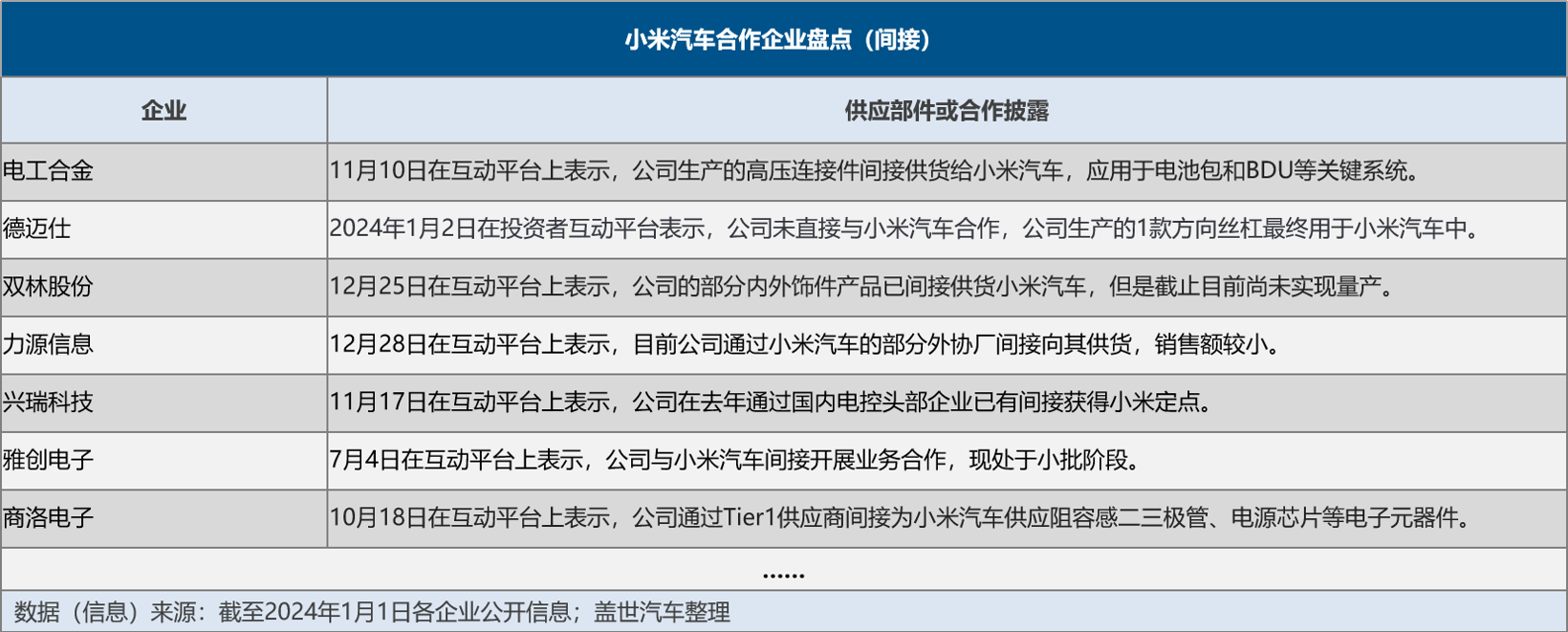
Electric alloy stated on the interactive platform on November 10 last year that the high-voltage connectors produced by the company are indirectly supplied to Xiaomi cars, and are used in key systems such as battery packs and BDU; Demaishi stated on the interactive platform on January 2, 2024 that the company did not directly cooperate with Xiaomi cars, and one type of steering screw produced by the company is ultimately used in Xiaomi cars. Other companies such as Shangluo Electronics and Shuanglin Stock have also indicated indirect cooperation. These companies may be suppliers of a certain Tier 1, but the final products are used in Xiaomi cars. As for the third type of company, the answers are ambiguous, and it is not clear whether they are cooperating with Xiaomi cars, or they indicate involvement in confidentiality agreements, including companies such as O-Film, Zhongke Chuangda, and Huayang Group, whose cooperation information has long been circulating on the internet.
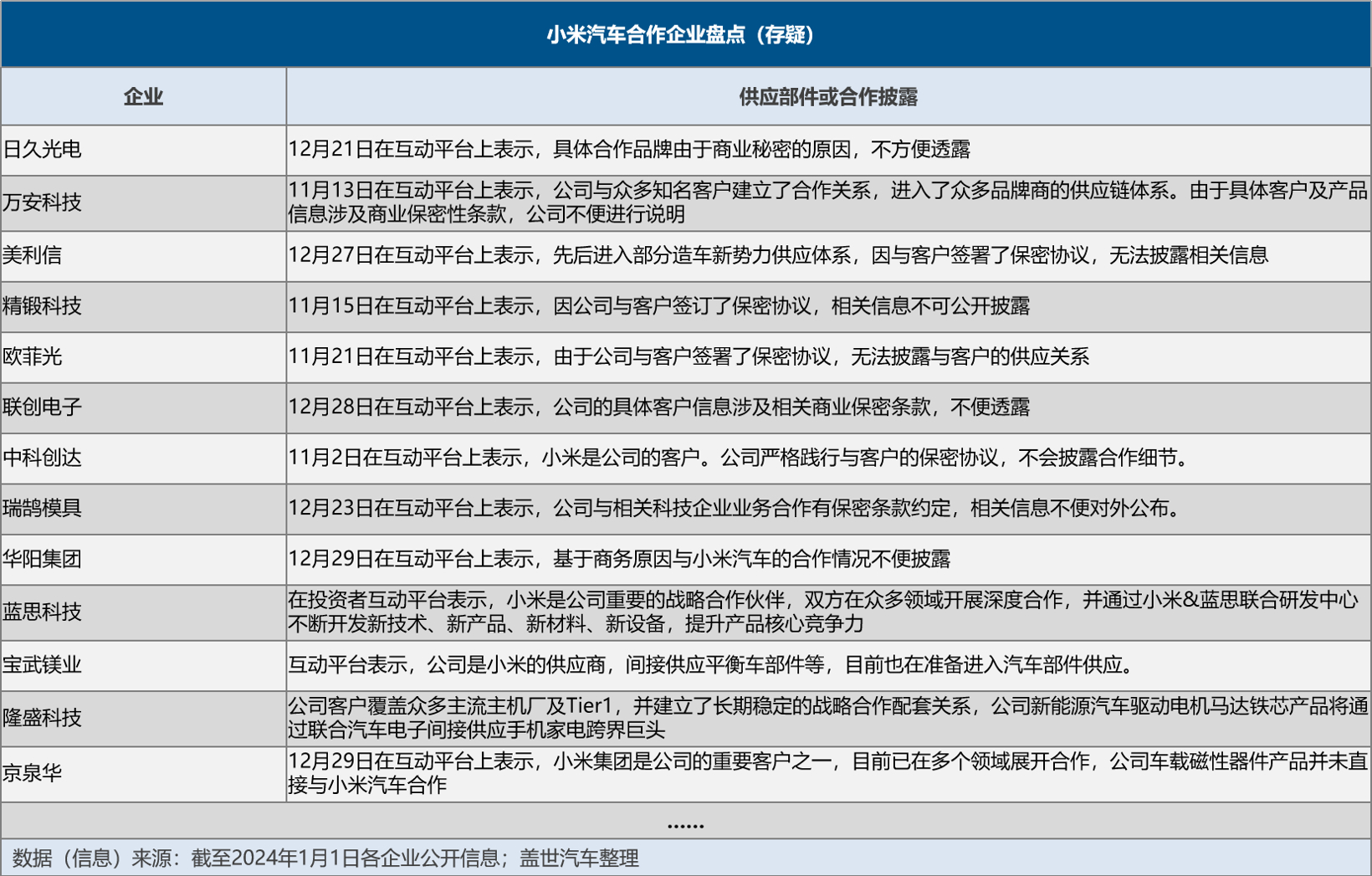
The last category is potential supply chain companies for Xiaomi’s cars, among which the backbone is the automotive industry chain companies that Xiaomi has invested in over the years. According to relevant statistics, since September 2021, Xiaomi Group and Shunwei Capital have accumulated investments in nearly 50 companies in the automotive field, covering areas such as automotive-grade chips, LiDAR, intelligent driving software solutions, wire control actuators, power batteries, and battery raw materials. The companies mentioned in the previous image, such as Fotech Technology, Jony Electronics, and Hesai Technology, are all companies in which Xiaomi has a stake. This extensive investment layout basically covers the upstream, midstream, and downstream of the automotive industry, helping Xiaomi to build a truly ecological chain, ensuring the continuous, stable, and effective operation of Xiaomi’s automotive industry chain, and at the same time, giving Xiaomi greater influence in the automotive industry chain. The emergence of a new car company is undoubtedly a big cake for the vast automotive supply chain behind it, which is also reflected in the stock market. For example, Huichuan Technology mentioned at the press conference, its stock price rose slightly by 0.67% on the day of the press conference on December 27, and continued to rise by nearly 4% the next day. To be honest, which car company does not have a huge supply chain system behind it? Relying solely on a single car company is not realistic. Even highly self-reliant car companies like BYD and Tesla cannot do without others. No matter how good the ingredients are, it depends on how well Xiaomi, the chef, cooks, not to mention that Xiaomi’s cars are not without self-research, and there seems to be a lot. What have they self-developed? According to incomplete statistics, at the Xiaomi car technology conference on that day, Lei Jun mentioned the word “self-developed” no less than 20 times, among which, battery management software, die-casting, intelligent driving, and chassis control algorithms are touted as fully self-developed. These self-developed areas cover Xiaomi’s five core automotive technologies: electric drive, battery, die-casting, intelligent cockpit, and intelligent driving.
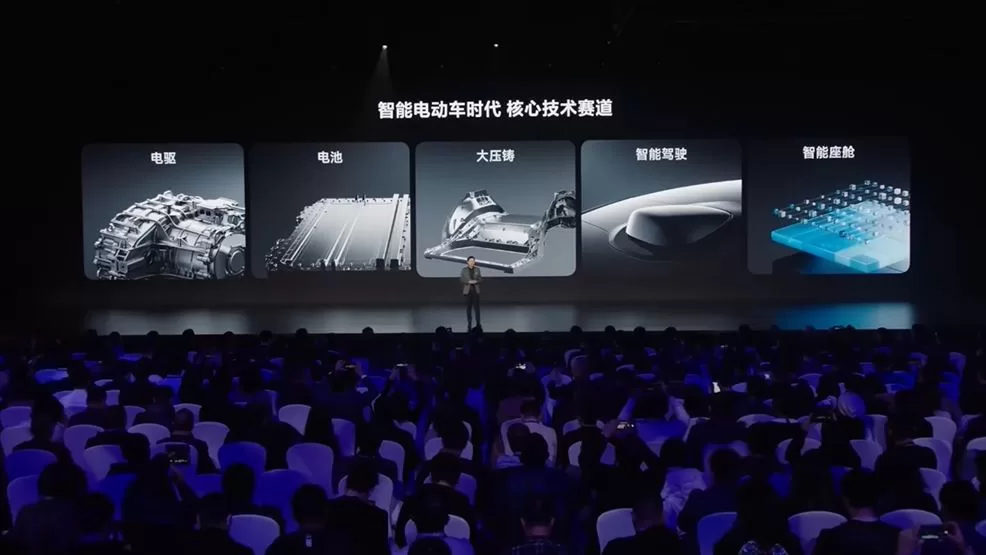
Image source: Xiaomi The V6, V6s, and V8s three super motors are the first big show of Xiaomi’s car. Among them, the 21000rpm ultra-high speed of V6 and V6s is undoubtedly a gorgeous data. Although the achievement of the world’s highest speed motor was intercepted by Huawei last November, Lei Jun bluntly said: “After carefully studying the motors of our competitors, we found that apart from the speed, they are much weaker than us in terms of highest power, maximum torque, power density and other three key indicators.”
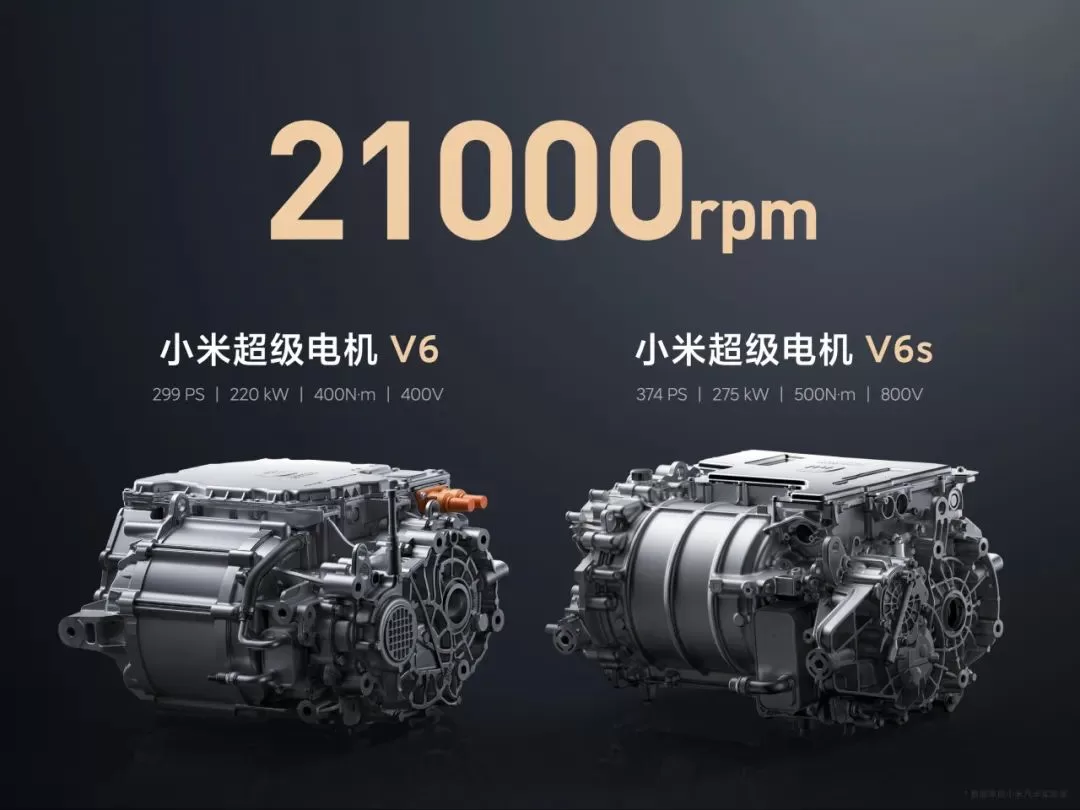
Image source: Xiaomi On this basis, Xiaomi announced its third self-developed and self-produced super motor: V8s, with a speed of 27,200rpm. There have been many doubts about these three motors on the internet, and Huichuan Technology stated after the press conference that it had participated in the joint development of Xiaomi’s super motor V6s, while the V8s motor is the result of Xiaomi’s full self-development for its cars. According to the introduction, in order to develop V8s, Xiaomi directly improved the materials, redesigned the motor cooling system, and equipped it with Xiaomi’s self-developed SiC electronic control module. The entire development process has applied for 155 patents, of which 60 have been authorized. Lei Jun stated that V8s is planned to be launched in 2025. In addition, the next generation of super motors pre-researched by Xiaomi’s cars, using carbon fiber laser curing winding technology, can achieve a maximum rotor speed of 35,000rpm in the laboratory. However, from a practical perspective, it is difficult for low-end car models to “bear” the high-speed motor development and application costs in the short term, which also means that the price of Xiaomi SU7 may be affected. As for the battery, Xiaomi stated that its CTB battery technology is self-developed, with a volume efficiency of 77.8%, and has also self-developed a new super 800V silicon carbide high-voltage platform, with a maximum voltage of 871V. Lei Jun also introduced that Xiaomi, together with CATL, has invested over a thousand R&D engineers for more than two years to jointly develop the Xiaomi 800V high-voltage battery pack, using its self-developed CTB integrated battery technology, with a maximum technical platform capacity of 150kWh and a range of over 1200km. Specific parameters are not elaborated here, but one highlight is its inverted cell technology. Xiaomi’s cars not only invert the cells, but also invert the pressure relief valves, providing greater protection for the users inside the car and further releasing the interior space. It is reported that Xiaomi has applied for 132 patents in the battery field, of which 65 have been authorized. Another thing to mention is Xiaomi’s self-developed 9100t large die-casting cluster.
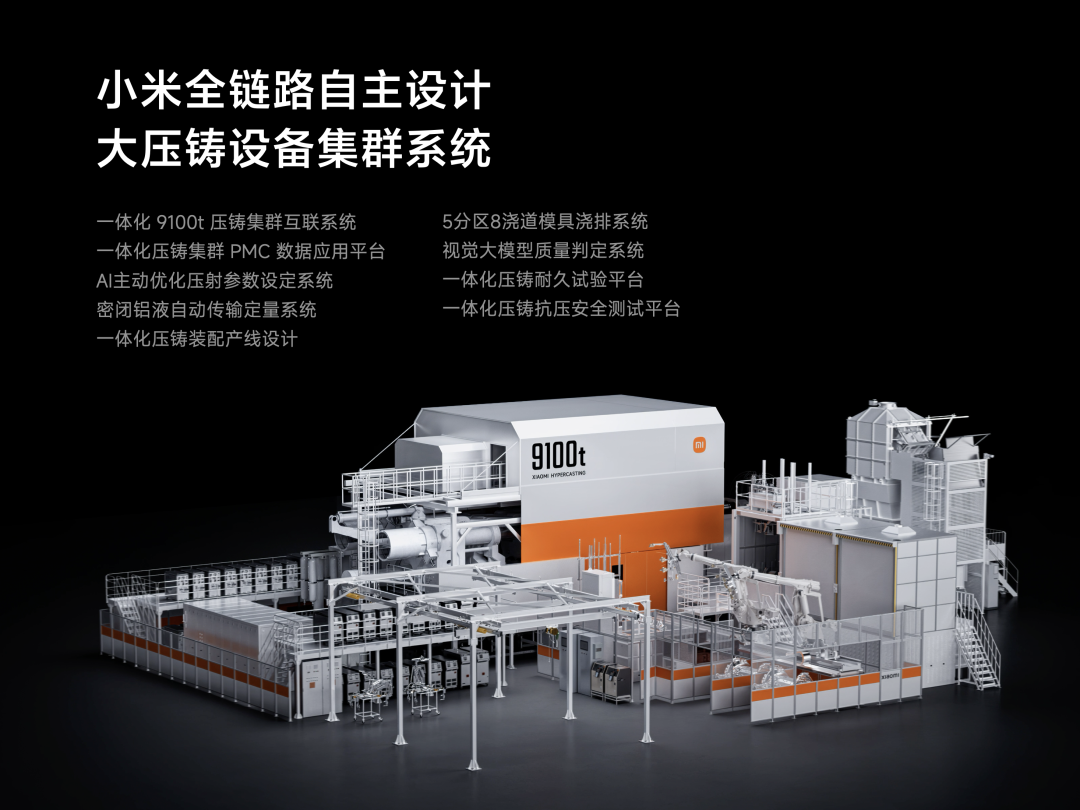
Image source: Xiaomi The application of large die-casting technology in the automotive industry has indeed become a development trend. Tesla is one of the powerful users and beneficiaries of this technology. It is expected that in the future, with the continuous breakthrough of die-casting machine tonnage and the improvement of mold technology, large die-casting technology will be more widely used in the automotive manufacturing industry. Xiaomi even independently developed a large die-casting material: Xiaomi Titan Alloy. To develop this material, Xiaomi’s material team cooperated with a national-level material key laboratory and independently developed a multi-material AI simulation system. In total, Xiaomi has become “the only domestic car manufacturer that can mass-produce independently developed large die-casting materials.” However, some believe that in terms of tonnage alone, it is not very significant. Ultimately, it depends on Xiaomi’s technology and production management. In the recently released “Xiaomi Car Answers 100 Questions from Netizens,” Xiaomi Car stated that Xiaomi’s integrated large die-casting floor is larger and more complex than Tesla Model Y, so it ultimately selected a rated locking force of 9100t. In actual use, Xiaomi’s super large die-casting locking force has a maximum value of 9500t, and the stable value can reach 9300t. “Locking force is not the only indicator of large die-casting technology. Performance of non-heat-treated alloy materials, die-casting island cluster design, defect detection, and so on are all core indicators of large die-casting technology,” said Xiaomi Car. It is reported that Xiaomi is currently the only car company in the world that simultaneously has independently developed non-heat-treated alloy materials and independently developed large die-casting island clusters in China. Xiaomi’s super large die-casting 9100t die-casting machine, jointly developed by Xiaomi and Haitian, has 11 patented design innovations based on the industry’s existing die-casting machine technology, most of which are invention patents, such as the AI active optimization of the injection parameter setting system. However, the die-casting machine is just one link. Xiaomi has independently developed the entire die-casting cluster system, including 60 devices and 433 process parameters. Currently, NIO, Xiaopeng, Geely, and others are also doing integrated die-casting, but the technology has a high threshold and requires a large amount of capital and technical support, suitable for a large single product line. Without a popular car model, it is difficult to cover the cost of integrated die-casting. However, Lei Jun is apparently quite satisfied with this large die-casting technology. Before the car is launched, Xiaomi has given a big red envelope to its “Integrated Large Die-Casting Technology” team. On January 4th, Lei Jun stated in his WeChat public account that the “Integrated Large Die-Casting Technology” team was awarded the Xiaomi Million Dollar Annual Technology Award. Another team that received this award is the “Xiaomi Surging OS New Architecture” team. Intelligence is the core. Making cars seems to be getting easier, but to stand out in the highly competitive car market, strong technological and innovative capabilities are required. Intelligence can be considered Xiaomi’s core competitiveness. At the end of October 2023, Xiaomi announced a comprehensive upgrade of its group strategy from “Mobile + AIoT” to “People, Cars, and Home Full Ecology,” with cars becoming the most important part of Xiaomi’s group strategy. Lei Jun announced at the press conference that with the addition of Xiaomi cars, Xiaomi’s “People, Cars, and Home Full Ecology” is officially a complete closed loop, with the most core part being the Xiaomi Surging OS. From the surface application point of view, the first point is the interconnection of mobile phones and cars, which is also being vigorously promoted by Huawei, Meizu, and others. From the current official demonstration, seamless connection and real-time collaboration between mobile phones and car machines have been achieved.
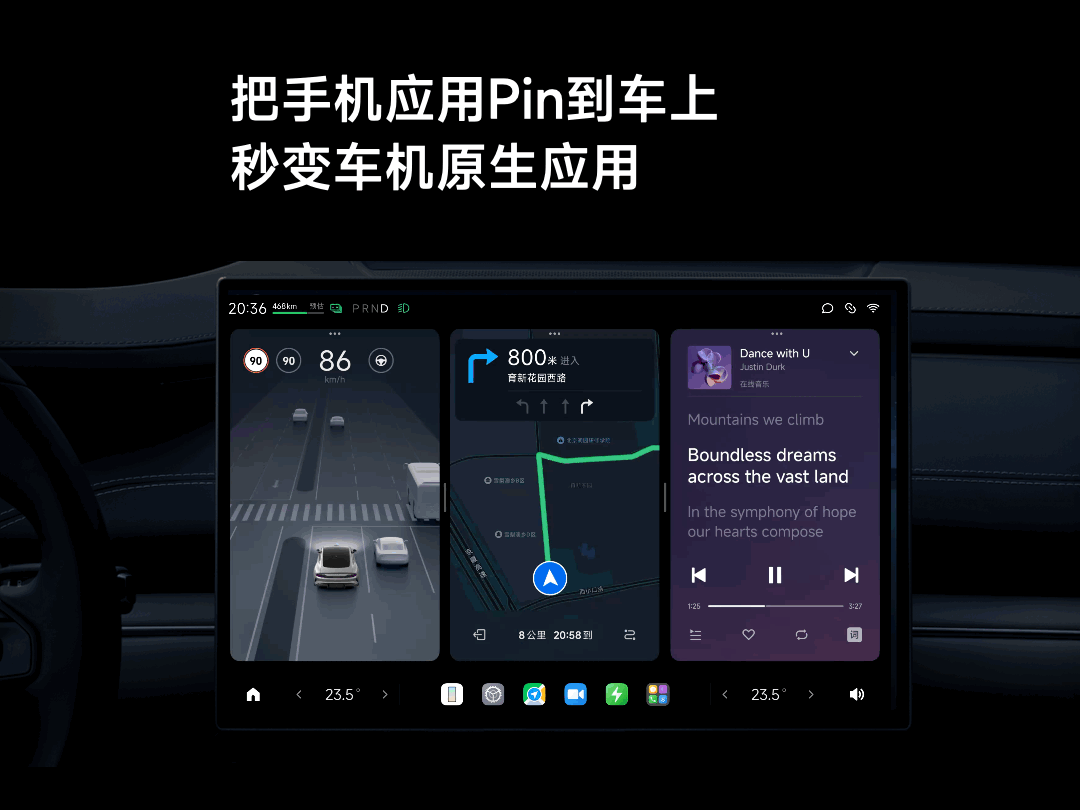
Image source: Xiaomi According to the introduction, Xiaomi’s SU7 cockpit system is compatible with mainstream car applications, and Xiaomi tablet ecosystem can seamlessly connect to the car. It is worth noting that, to cater to Apple users, Xiaomi’s car also supports wireless CarPlay, AirPlay, and even supports iPad rear seat expansion, controlling air conditioning, music, and seats. Xiaomi also introduced the CarIoT ecosystem, which can be simply understood as an external device ecosystem for Xiaomi cars. The central large screen, storage compartment, and rear seat all support hardware expansion, with hardware ecosystem expansion supported on all four sides of the central screen, traditional physical car keys can be installed on the central screen in the form of external devices through magnetic suction. Xiaomi’s car is the last step in the “people, car, and home” ecosystem. After the user logs into the same Xiaomi account, Xiaomi devices can be seamlessly connected to the car. In terms of intelligent driving, Xiaomi’s intelligent driving adopts the latest generation of underlying algorithms: BEV+Transformer+network occupancy, and fully integrates large model technology. This technology route is not unique to Xiaomi cars, but the focus is on the innovation of its three perception technologies: zooming BEV technology, super-resolution network occupancy technology, and road large model technology.
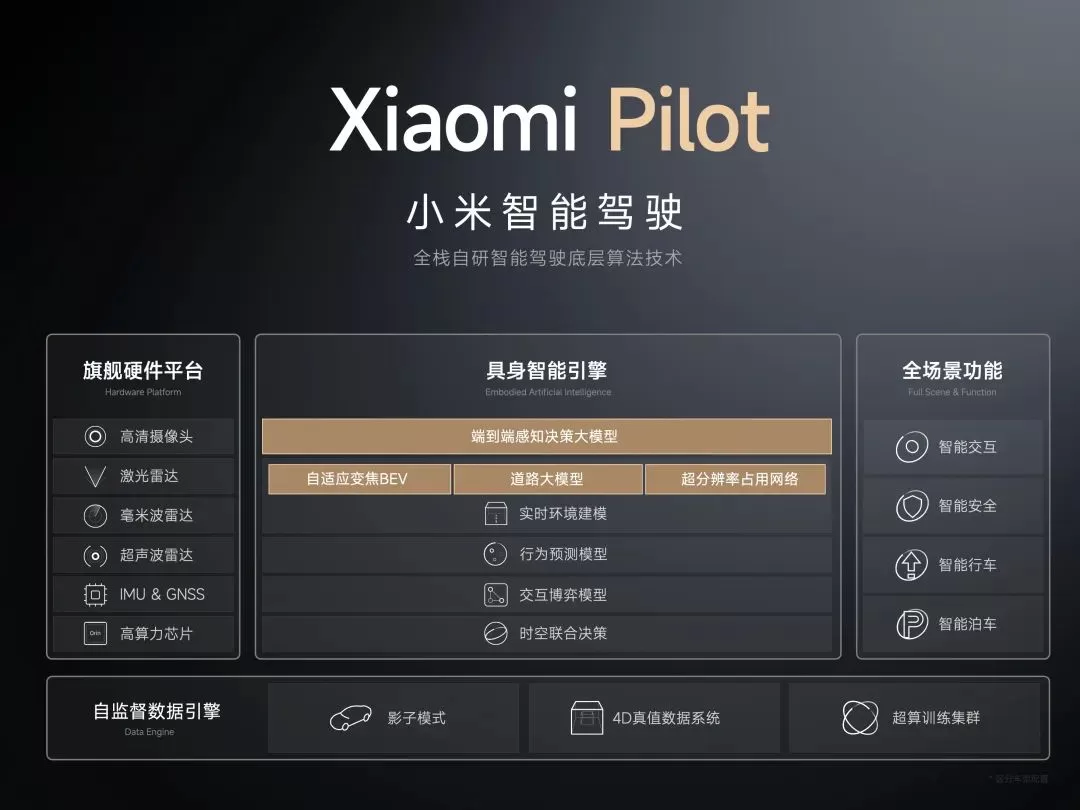
Image source: Xiaomi BEV zoom technology is similar to a bird’s-eye view, achieving precise perception of the environment in different scenarios by dynamically adjusting the perception range. Super-resolution network technology adds super-resolution vector algorithms to network technology, simulating all visible objects on the road as continuous curved surfaces to improve recognition accuracy. The third technology is “road large model technology,” mainly for real-time generation of road topology, but it can be seen that Xiaomi’s car is also preparing for mapless intelligent driving. In addition, Xiaomi’s car claims to have independently developed end-to-end perception decision-making large model, the first time it has been applied to mass-produced cars worldwide. All of this naturally requires powerful computing platforms and perception hardware as support. Two NVIDIA DRIVE Orin high-power chips, with a comprehensive computing power of 508 TOPS, combined with 1 LiDAR, 11 HD cameras, 3 mm-wave radars, and 12 ultrasonic radars, are Xiaomi’s answer. From the official video, it can be seen that Xiaomi’s car does have good intelligent driving performance, but because the car has not officially launched, it is still difficult to accurately judge. It can only be said that achieving the goal of “entering the first tier of intelligent driving in 2024” is not easy. The road to the top Regarding Xiaomi’s car’s technical research and development goals, a summary can be made using a diagram of Xiaomi’s car’s Modena technology architecture.
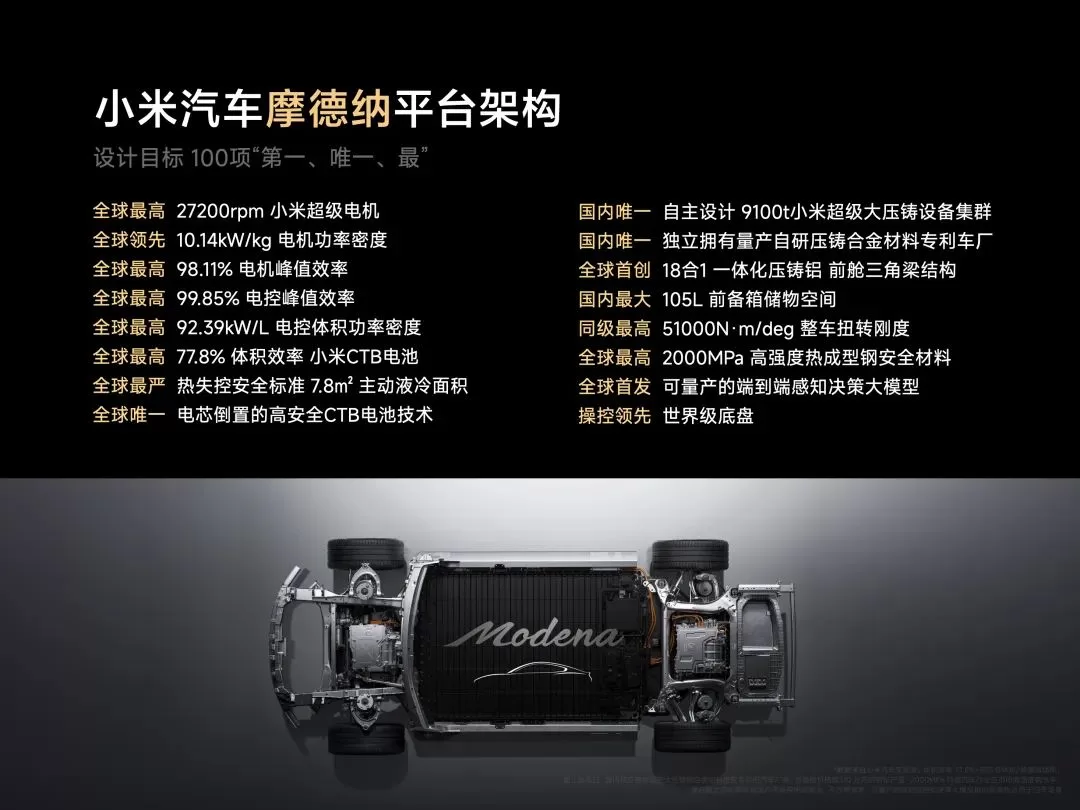
Image source: Xiaomi 100 global “highest”, “only”, “largest” and other descriptions, regardless of whether they violate the “Advertising Law” or not, from a paper perspective, Xiaomi has shown great sincerity, but there are not many surprises. The core functions of smart car technology, such as autonomous driving, intelligent cockpit, etc., have become standard features of smart cars. Different brands of smart cars tend to have similar functions, making it difficult for consumers to differentiate between different brands based on functionality alone. As for the specific performance of the functions, it’s a matter of personal preference. Except for some “lagging” models, users will find it increasingly difficult to perceive technological differences in the same functions. In order to compete for market share, some car manufacturers may choose to follow mainstream trends, adopting similar technologies and designs. At this point, it is important to consider each brand’s own characteristics and advantages. Where does Xiaomi excel? Compared to the “predecessors” admired by Lei Jun, the increasingly mature industrial chain has brought favorable conditions to Xiaomi’s cars, but the market competition environment faced by Xiaomi’s cars is also quite different. Xiaomi’s cars are benchmarked against Porsche, Tesla, and the competitors like Huawei that are openly or secretly compared. Their cars have their own technological advantages, but they are not cheap. It is worth mentioning Huawei, it cannot be denied that the Ask and Wisdom series of cars are sold at a high price, in addition to Huawei’s technological empowerment, the Huawei brand’s endorsement cannot be underestimated. And the brand image of Huawei and Xiaomi is also different. It can be said that Xiaomi’s entry into the high-end market is indispensable for the Xiaomi brand, and the high-end transformation of the Xiaomi brand has already achieved certain results, as can be seen from the hot sales of models like Xiaomi 14. However, in the short term, Xiaomi’s image as a cost-effective brand may not have fundamentally changed. High-end and high prices are generally positively correlated, but in the current market where prices are dominant, Xiaomi’s ultimate core competitiveness for cars may still be price, or rather cost-effectiveness, as well as its large user base and smart ecosystem. These days, Xiaomi’s cars are either denying rumors or on the road to denial.
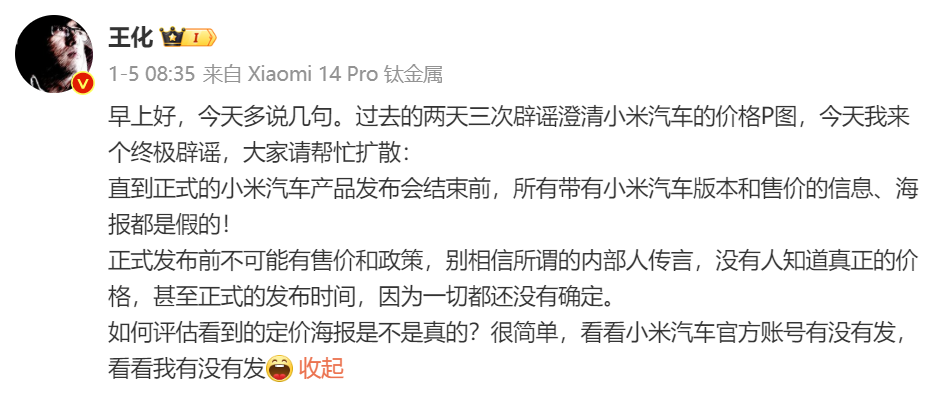
Source of image: Wang Hua Weibo The price of the SU7 may not be as affordable as users previously imagined, Xiaomi Car has made it clear that the price of the Xiaomi SU7 will not be 99,000, 149,000, or 199,000. Some users chanted the slogan “It’s not that Xiaomi can’t afford it, but Redmi offers better value for money, Redmi Car, I’m waiting for you,” but this idea was also killed in its cradle. Facing the question of whether Xiaomi will create an even lower-priced version to reduce the starting price, Xiaomi Car stated directly that there is a fully consistent product approval guideline within Xiaomi Car, with “experience first” always being the top priority. The Xiaomi SU7 is the standard version. Xiaomi Car also stated that there are no plans to launch Redmi cars. The new energy vehicle market is currently an incremental market, and with the recent high-end transformation of Chinese car companies in recent years, there has been a significant increase in user acceptance of domestic new energy vehicles and even high-end smart electric vehicles, leaving Xiaomi Car with a lot of room for development. Lei Jun previously replied to a netizen in the comments section, saying that there is no competition for Xiaomi cars under 500,000, and Xiaomi Car stated, “Although it’s a joke, it’s also serious.” Xiaomi Car’s target users will definitely not be limited to Xiaomi users, whether they can get a broader user base to pay the bill, and let the bullets fly a while longer.